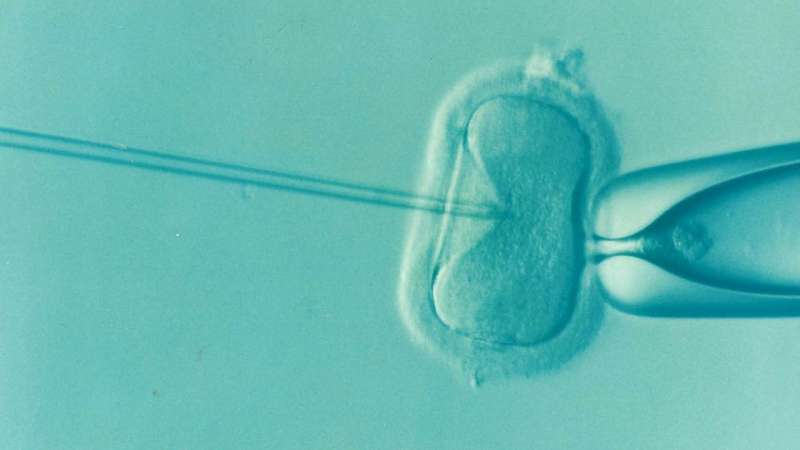A step forward for IVF patients with predicted poor response to treatment

Fertility patients who have a poor response to ovarian stimulation represent a stubborn challenge in IVF. Few eggs are collected, success rates are low, and several treatments are usually needed to achieve pregnancy (if at all). Clinical guidelines indicate that increasing the drug dose for stimulation or applying any of several adjunct therapies are of little benefit. Now, however, a study assessing two cycles of ovarian stimulation and two egg collections in the same menstrual cycle may yet provide a real advance for predicted poor responders in IVF.
A randomised trial performed in Spain has found that this double stimulation approach—known as "DuoStim"—is just as efficient as two conventional stimulations in different cycles and importantly reduces the time to pregnancy in a group of patients who rarely have time on their side. "This is of great clinical utility," said Dr. Maria Cerrillo Martinez, presenting the study results at ESHRE's online annual meeting on behalf of her colleagues at IVIRMA in Madrid. Dr. Cerrillo added that this was the first randomised trial to compare the efficiency of single-cycle DuoStim with two conventional treatments in separate cycles.
The study took place throughout 2017 and 2020 in a total of 80 IVF patients scheduled for embryo testing (PGT-A for chromosomal normality). All were aged over 38 and their reproductive history and ovarian reserve tests predicted a low response to ovarian stimulation—with few eggs collected and a likely poor outcome. They were randomised to two conventional cycles of stimulation or to DuoStim, and results were significantly in favour of the latter.
While the initial "laboratory" response to stimulation was comparable between the two groups in terms of eggs collected and healthy embryos developed, there was a significant difference in the average number of days it took to develop a chromosomally normal embryo ready for transfer. The DuoStim group reached this point in an average of 23 days from the start of stimulation, while the conventional two-treatment group took an average of 44 days. There was also a trend towards higher fertilisation and blastocyst-formation rate in the DuoStim group.
Since the earliest days of IVF treatment, whether in a natural or stimulated cycle, treatment has always involved a single attempt in a single cycle. Stimulation has always been with fertility hormones known as gonadotrophins with the aim of producing multiple eggs for collection and fertilisation. The idea of stimulating the ovaries twice in the same cycle has seemed counterintuitive, but, says Dr. Cerrillo, the concept is quite in tune with the biology of the ovary.
"Classically," she explained, "only one cohort of follicles has been recruited in the early 'follicular' phase of the cycle. However, we know from data in other species that stimulation in the second 'luteal' phase of the cycle was also possible. So some women having fertility preservation before cancer treatment and with little time to spare were stimulated as soon as they came to the IVF unit, and they usually responded normally. It's the same principle behind DuoStim—that we can recruit a cohort of follicles on any day of the cycle."
So far, the benefits of a dual stimulation strategy seem to be concentrated on time to pregnancy and the generation of several eggs in a treatment group usually associated with very few. Studies so far have also found that fewer patients have dropped out of treatment programmes because of the shorter time required.
So far, guidelines for IVF have described DuoStim as only of experimental application, but, says Dr. Cerrillo, "we think it's a great alternative for predicted poor responders who might otherwise have difficulties reaching blastocyst transfer from just one egg pick-up". She added that her own clinic in Madrid now has DuoStim experience in more than 500 patients. "Hopefully, the experimental recommendation will change with more data like ours being published."
Dr. Cerrillo emphasised that the dual stimulation strategy was so far applicable mainly to a group of patients whose ovarian reserve tests—such as AMH—indicated a poor response to stimulation. "But we also need to consider the most relevant marker of prognosis, patient age. So the patients we're looking at are those with poor ovarian reserve, who are often at an older maternal age," she said.
"So if the patient is a good responder, we may not need more eggs or more embryos—and dual stimulation would not be necessary," explained Dr. Cerrillo. "However, it may be a good alternative in poor responders, in fertility preservation patients with time constraints, or even in egg donors, whose aim is to maximise the number of eggs retrieved in a single treatment."
More information: Presentation 0-111, Tuesday 29 June 2021: The DuoStim strategy shortens the time to obtain an euploid embryo in poor prognosis patients: a non inferiority, randomized controlled trial















